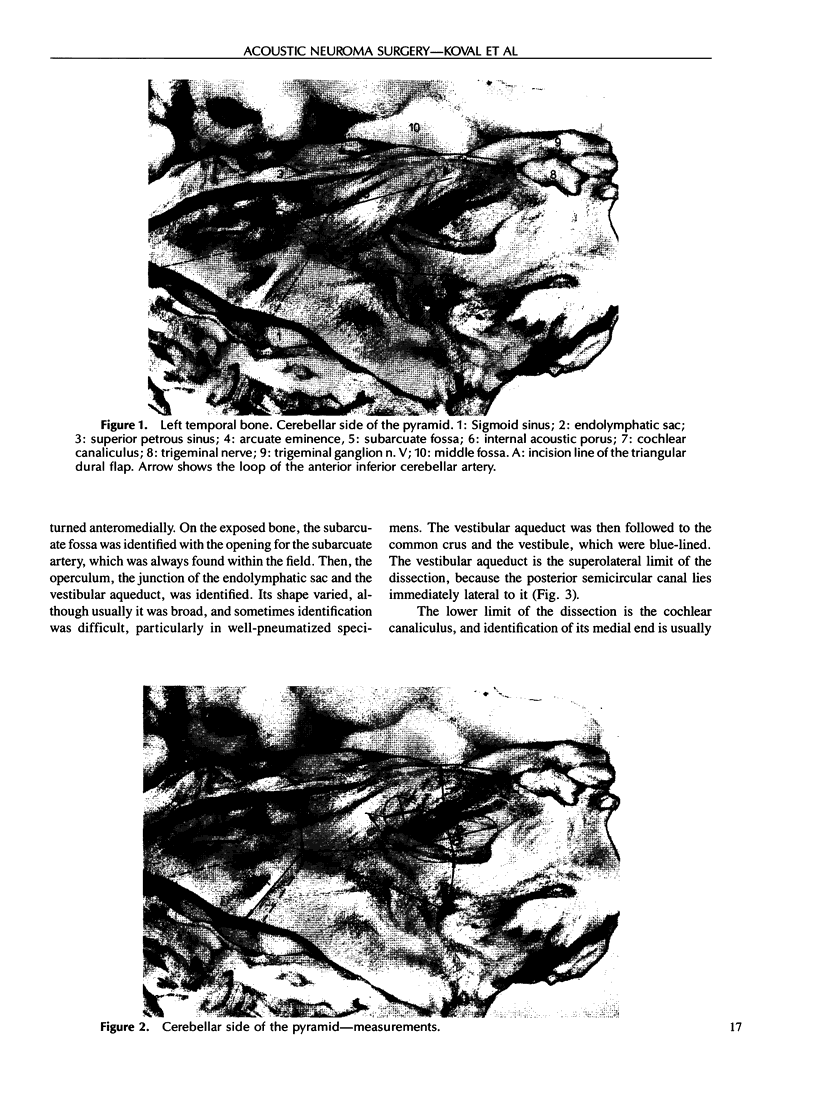Abstract
The limitations of the transmeatal phase of the retrosigmoid transmeatal approach are shown, and the problems of opening the internal acoustic meatus via this approach and the criteria for its use are discussed.
Full text
PDF





Images in this article
Selected References
These references are in PubMed. This may not be the complete list of references from this article.
- Anson B. J. Critical distances in the middle and inner ear and in the posterior cranial fossa. Trans Am Acad Ophthalmol Otolaryngol. 1972 Jan-Feb;76(1):108–129. [PubMed] [Google Scholar]
- Bouguet D., Brinquin L., Vilotte A., Desgeorges M., Sterkers J. M. L'anesthésie dans la chirurgie des neurinomes de l'acoustique par voies trans-pétreuses. Ann Otolaryngol Chir Cervicofac. 1986;103(7):479–484. [PubMed] [Google Scholar]
- Domb G. H., Chole R. A. Anatomical studies of the posterior petrous apex with regard to hearing preservation in acoustic neuroma removal. Laryngoscope. 1980 Nov;90(11 Pt 1):1769–1776. doi: 10.1288/00005537-198011000-00003. [DOI] [PubMed] [Google Scholar]
- Geurkink N. A. Surgical anatomy of the temporal bone posterior to the internal auditory canal: an operative approach. Laryngoscope. 1977 Jun;87(6):975–986. doi: 10.1288/00005537-197706000-00015. [DOI] [PubMed] [Google Scholar]
- Harner S. G., Beatty C. W., Ebersold M. J. Retrosigmoid removal of acoustic neuroma: experience 1978-1988. Otolaryngol Head Neck Surg. 1990 Jul;103(1):40–45. doi: 10.1177/019459989010300106. [DOI] [PubMed] [Google Scholar]
- Kartush J. M., Telian S. A., Graham M. D., Kemink J. L. Anatomic basis for labyrinthine preservation during posterior fossa acoustic tumor surgery. Laryngoscope. 1986 Sep;96(9 Pt 1):1024–1028. [PubMed] [Google Scholar]
- Lang J. Clinical anatomy of the cerebellopontine angle and internal acoustic meatus. Adv Otorhinolaryngol. 1984;34:8–24. doi: 10.1159/000409831. [DOI] [PubMed] [Google Scholar]
- Roland P. S., Meyerhoff W. L., Wright C. G., Mickey B. Anatomic considerations in the posterior approach to the internal auditory canal. Ann Otol Rhinol Laryngol. 1988 Nov-Dec;97(6 Pt 1):621–625. doi: 10.1177/000348948809700608. [DOI] [PubMed] [Google Scholar]
- Silverstein H., Norrell H., Haberkamp T. A comparison of retrosigmoid IAC, retrolabyrinthine, and middle fossa vestibular neurectomy for treatment of vertigo. Laryngoscope. 1987 Feb;97(2):165–173. doi: 10.1288/00005537-198702000-00007. [DOI] [PubMed] [Google Scholar]
- Silverstein H., Norrell H., Smouha E., Haberkamp T. The singular canal: a valuable landmark in surgery of the internal auditory canal. Otolaryngol Head Neck Surg. 1988 Feb;98(2):138–143. doi: 10.1177/019459988809800207. [DOI] [PubMed] [Google Scholar]
- Smith M. F., Lagger R. L. Hearing conservation in acoustic neurilemmoma surgery via the retrosigmoid approach. Otolaryngol Head Neck Surg. 1984 Apr;92(2):168–175. doi: 10.1177/019459988409200209. [DOI] [PubMed] [Google Scholar]








